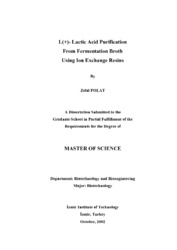Please use this identifier to cite or link to this item:
https://hdl.handle.net/11147/4041| Title: | L[+]-Lactic Acid Purification From Fermentation Broth Using Ion Exchange Resins | Authors: | Polat, Zelal | Advisors: | Harsa, Hayriye Şebnem | Publisher: | Izmir Institute of Technology | Abstract: | Lactic acid exists in two optically active form, D(-) and L(+)-lactic acid. It has been used in food, leather, textile, pharmaceutical and cosmetic industries. Moreover, L(+)-lactic acid constitutes the raw material for the production of poly-L-lactic acid which is used in biomedical applications.The aim of this study was to recover and purify the microbially produced L(+)-lactic acid from the fermentation media efficiently and economically. Among the various downstream operations, ion exchange chromatography was used since it is highly selective and yields a low cost product recovery within a short period of time. The additional goals were to investigate the end product purity, to obtain new data on the adsorption/desorption behaviours of lactic acid and to investigate the applicability of the system for industrial usage. In this project, Lactobacillus casei NRRL B-441 was used for the production of L(+)-lactic acid from whey by a 12 hours fermentation process at pH 5.5 and 37 oC. The product concentration was 50 g/l with 100% L(+)-lactic acid content. Then, a suitable resin with high sorption capacity and rapid equilibrium behavior was selected. The selected resin was Dowex marathon WBA, a weakly basic anion exchanger in OH form. It reached the equilibrium state in 15 minutes. The batch sorption experiments were done at pH 7.0 and 30 oC and sampling was continued for 20 hours. Furthermore, the effect of temperature and pH was investigated and their influence was found to be unimportant. All the adsorption/desorption experiments were applied both to model lactic acid and to biomass free fermentation broth. The ion exchange equilibria of lactic acid and L(+)-lactic acid in fermentation broth on Dowex marathon WBA were explained by the Langmuir isotherm. The maximum exchange capacity (qm) for model lactic acid was 0.25 g La/g wet resin, while L(+)-lactic acid in fermentation broth has a qm value of 0.04 g La/g wet resin. The equilibrium loading and exchange efficiency of L(+)-lactic acid in fermentation broth were reduced as a result of competition by other ionic species. The competing ions inhibit the binding of L(+)-lactic acid to the free sites of ion exchanger. Moreover, column operations were applied to recover sorbed lactic acid from the ion exchanger. 2.0 M HCl was found to be a suitable eluting agent to recover the bound L(+)-lactic acid with a flowrate of 1 ml/min at ambient temperature. About 95 % of bound L(+)-lactic acid was recovered from Dowex marathon WBA. | Description: | Thesis (Master)--Izmir Institute of Technology, Biotechnology, Izmir, 2002 Includes bibliographical references (leaves: 86-89) Text in English;Abstract: Turkish and English vii, 96 leaves |
URI: | http://hdl.handle.net/11147/4041 |
| Appears in Collections: | Master Degree / Yüksek Lisans Tezleri |
Files in This Item:
| File | Description | Size | Format | |
|---|---|---|---|---|
| T000162.pdf | MasterThesis | 239.4 kB | Adobe PDF |  View/Open |
CORE Recommender
Page view(s)
394
checked on Apr 28, 2025
Download(s)
236
checked on Apr 28, 2025
Google ScholarTM
Check
Items in GCRIS Repository are protected by copyright, with all rights reserved, unless otherwise indicated.